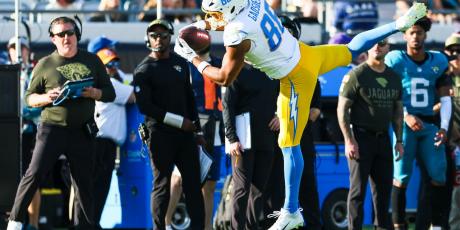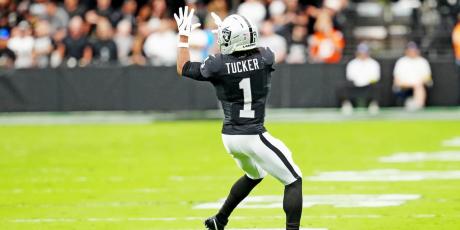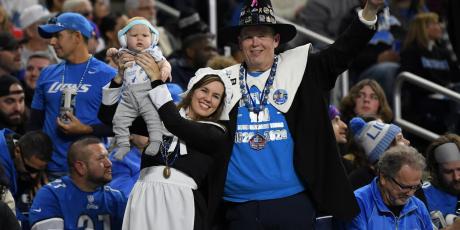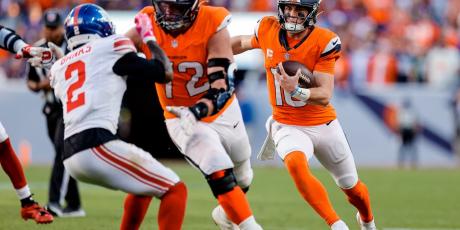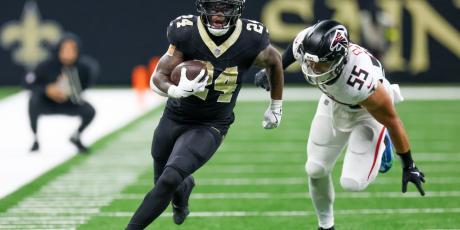TJ's Targets: 17 Players I Want in Every Fantasy Draft

The vast majority of fantasy football drafts happen in the one or two weeks leading up to the season, but I’ve been drafting since spring. With upwards of 100 drafts under my belt, the following is a list of the players that I’ve drafted the most and am still drafting, or have started targeting heavily in recent drafts.
In order to discuss a player’s value, I’ve included Underdog ADP but you can get an idea of where my favorite players might go in your league by checking out 4for4’s Multi-Site ADP.
Check out the 29 players John Paulsen wants to draft everywhere!
Quarterbacks
A Top-7 Quarterback
Last year, I predicted an outlier season for quarterback scoring and that came to fruition—many of the factors that led to last year’s uber-elite tier of quarterbacks remain in 2021. I’ve laid out the framework for what I believe the quarterback landscape will look like this season which is that we have a tier of mobile, high-efficiency passers that the rest of the league just can’t keep up with. Sure, Aaron Rodgers and Tom Brady sat comfortably in the QB1 ranks last year but I don’t want to NEED 40 touchdowns just keep up with the Josh Allens and Lamar Jacksons of today.
As noted in the league trends article linked above, quarterback ADP has become steadily more efficient over the years meaning that it’s getting tougher each season to find QB1 production from quarterbacks that aren’t drafted as such. I’m not paying all the way up for a third-round quarterback but if my league doesn’t go quarterback crazy, I want to close out the quarterback tier of Russell Wilson or Justin Herbert around the 80th pick, foregoing the late-round approach I’ve long advocated for.
Ryan Tannehill, Titans (ADP: 112, QB12)
Tannehill is the only quarterback that we know can have enough mobility and efficiency to match the top tier of quarterbacks. Since joining the Titans in 2019, no quarterback has averaged more fantasy points per pass attempt (excluding rushing numbers) than Tannehill. The problem is that he ranks 24th in pass attempts in that span, playing in an offense that relies heavily on Derrick Henry.
With Julio Jones added to the mix, the passing upside is obvious—if anything were to happen to Henry, this year’s Titans could be last year’s Bills. On the other hand, if you miss out on the top-end quarterbacks, you can likely get Tannehill as the last quarterback in your draft and Tennessee starts the season with a potential shootout against the Cardinals.
Tua Tagovailoa, Dolphins (ADP: 141, QB17)
There isn’t a quarterback that I’ve drafted more this year than the Dolphins’ second-year signal-caller. If you’re in a 2-QB league or you miss out on the recommendations above somehow, Tua is your target. Miami already had a decent pass-catching duo with DeVante Parker and Miek Gesicki but they put it all in Tua’s corner by signing Will Fuller and drafting Jaylen Waddle.
The Dolphins already threw at a top-10 neutral rate last season and a second-year bump with their quarterback could have them near the top-five in that category. With three games over 20 rushing yards last season, Tagovailoa does enough on the ground that he might offer an occasional overall QB1 weekly ceiling.
Running Backs
Najee Harris, Steelers (ADP: 18, RB12)
The chances of landing a top-eight running back are largely dependent on your draft slot but in the second round, there's a handful of running backs whose ADPs are largely interchangeable. Underdog currently shows six running backs going in the second round and if I’m picking one of the fringe RB1s, it’s Harris.
The rookie immediately steps into a situation with virtually no backfield competition—he is projected for the ninth-most touches in the league and has the skill set to approach 50 catches. Per John Paulsen:
“The last 10 first-round rookie running backs who drew at least 10 starts averaged 284 touches for 1,424 total yards and 9.4 touchdowns or 15.1 PPG (half-PPR)”
Sign me up.
Trey Sermon, 49ers (ADP: 72, RB26)
Underdog drafters are a bit higher than consensus with the 49ers rookie going 85th in consensus ADP—I’d expect to see him drafted there or lower in most home leagues.
San Francisco traded up to get Sermon in what should be a timeshare with Raheem Mostert, at least to start the season. Even an even split in a Kyle Shanahan backfield is valuable, though. Usually, narratives surrounding coaches and positional groups are unfounded or anecdotal but Shanahan really does love giving running backs the ball.
Devonta Freeman posted overall RB1 numbers under Shanny and since taking over the 49ers, San Francisco has finished 4th > 2nd > 15th > 8th in team half-PPR running back points. Shanahan is also the only play-caller besides Kevin Stefanski whose backfields have averaged over 60% of team touches.
Mostert has flashed when given the opportunity but he hasn’t been able to stay healthy or take grips on the clear RB1 role when given the chance. WIth Jeff Wilson sidelined to start the season, this should be a backfield duo instead of the trio we’ve seen in recent years and the 49ers went out of their way to make sure they had Sermon be a part of it.
Tony Pollard, Cowboys (ADP: 122, RB38)
If you view Pollard as a pure handcuff, then his current ADP is probably a touch too high, but Paulsen’s 145-touch projection suggests that Ezekiel Elliott’s backup should have some stand-alone value. We’re not going after a pick like Pollard for his median projection, though. We’re buying his range of outcomes. A lot of players will have “league-winning upside” attached to their name but there are only so many offenses that have the potential to be the best in the league—Dallas is one of them.
If his role grows even a little from the nine touches per game that he saw from Week 4 on last season when Zeke played, Pollard could be worthy of bye week spot starts. An injury to Zeke makes Pollard the hottest name in football.
Wide Receivers
Calvin Ridley, Falcons (ADP: 13, WR4)
If ADP plays out as shown on Underdog, I’m ecstatic taking Ridley at the turn—if he’s available at 17 like he is across all platforms, there arguably isn’t another player worth considering. With Julio Jones still in Atlanta last season, albeit for just nine games, Ridley finished seventh in targets and as the WR4 in half-PPR leagues. With Julio in Tennessee and Ridley’s main competition from a rookie tight end, the league lead for targets is well within Ridley’s range.
What gives Ridley overall WR1 upside isn’t just the volume that he sees, but the type of volume. His 43.2% share of air yards led the league in 2020 and his 15.1 air yards per target led all receivers with at least seven targets per game by a significant margin. He also led the league in end zone targets. Ridley gets volume and the highest-value volume there is. Draft him when you can.
Robert Woods, Rams (ADP: 33, WR14) & Cooper Kupp, Rams (ADP: 36, WR17)
Targeting concentrated passing games helps narrow the range of outcomes in an offense since we can easily project where most targets are going beyond just the top wide receiver. When healthy, Woods and Kupp combined for nearly half of the Rams targets last season and that target share has been quite consistent over their entire time together.
Woods finished as the WR13 in half-PPR leagues last while Kupp finished as the WR26 despite seeing just five fewer targets. Woods’s production was largely in line with his volume but Kupp’s numbers suffered because he found the end zone just three times. Expect his scoring numbers to bounce back.
Both receivers get a huge boost with Matthew Stafford under center. Over the last two seasons, Jared Goff has been among the least efficient passers in the league, ranked 23rd out of 32 qualified passers in adjusted yards per attempt and 28th in touchdown rate. In that span, Stafford ranks ninth in both categories. I’m heavily targeting wide receivers in the middle rounds and almost always landing one of these two Rams.
D.J. Moore, Panthers (ADP: 42, WR20)
After finishing as the WR22 in half-PPR leagues last year while competing with Robby Anderson and Curtis Samuel for targets, Moore is arguably being drafted at his floor with Samuel out of the picture. Sure Christian McCaffrey will be back but Mike Davis saw 70 targets last season, the fifth-most among running backs.
Moore popped as one of the better route runners in the league against all coverages in Matt Harmon’s Reception Perception and has an opportunity to separate himself as a true number one in 2020. Surprisingly, Moore led all receivers in average target depth last year (that’s typically been Anderson’s role) and the switch to Sam Darnold from Teddy Bridgewater may let Moore turn his downfield routes into fantasy points. Bridgewater ranked 15th in deep-ball rate last season while Darnold threw deep at the fifth-highest clip.
Odell Beckham, Browns (ADP: 57, WR28)
In drafts where I start wide receiver heavy, Beckham has been a near auto-pick for me as my WR4 or WR5. It’s easy to say Odell is washed but we still haven’t seen him with the improved Baker Mayfield that we saw in the second half of last year, since Beckham’s season ended in Week 7.
Prior to his Week 7 injury, Beckham was seeing a team-leading 7.2 targets per game, accounting for 37.9% of Cleveland’s air yards, a top-10 share in the league at that point. With Mayfield’s improvement, the Browns slowly transitioned to a pass-first team down the stretch, ranked seventh in neutral passing rate from Weeks 13–17. If they maintain an offense even close to what we saw late in the year, I want the WR1 there.
Michael Gallup, Cowboys (ADP: 77, WR 38)
Gallup is another player who sharp fantasy drafters have been targeting aggressively but is slipping in more casual leagues with an ADP comfortably in the hundreds on most sites besides Underdog. He has been deployed mainly as a deep threat in Dallas but camp reports suggest that he will be moved around more and used in an expanded role in 2021. That jives with his and the rest of the receiving corps skillset. This is arguably the best receiving trio in the league and could contend for the top-scoring offense. Targeting cheap pieces of teams like the Cowboys is a winning strategy.
Will Fuller, Dolphins (ADP: 87, WR41)
Put any of the Dolphins’ top four pass-catchers in this space and I’m happy but the fact that Fuller is being drafted outside the WR3 ranks is one of the biggest inefficiencies in 2021 drafts. All Fuller did last season was pace as the WR5 before his suspension. Now he is going to an offense that could make one of the biggest leaps in the league with Tagovailoa going into his second year and a beefed-up pass-catching corps. While Fuller likely won’t see the target volume to offer WR1 upside, he has week-winning potential every time he’s in your lineup.
Gabriel Davis, Bills (ADP 140: WR66)
This is another player where the public sentiment is glaringly low compared to players that have been drafting all summer. While Davis, Emmanuel Sanders and Cole Beasley are all being drafted next to each other on Underdog, Davis is going largely undrafted on other platforms. Stefon Diggs is the clear top dog in Buffalo but the pecking order after that is somewhat murky.
Beasley just had his best season after eight years in the league but there are rumblings of him being a cut candidate and Sanders is switching teams in his age-34 season. Those two likely start the year in three-wide sets with Diggs but Davis dominated downfield, showed improvement in his route-running as the season progressed last year, and is arguably better than both on the outside—if he continues to grow, it will be tough to keep him off the field. Taking Sanders or Beasley is far from a wasted pick, but I want a piece of a Josh Allen, especially the big-play candidates, and Davis is that player.
Tight Ends
Travis Kelce, Chiefs (ADP: 7, TE1)
While we are mostly at the mercy of our draft slot in the first round, it’s worth noting how valuable Travis Kelce is with a pick in the middle. If the top four or five backs and Davante Adams are gone, I’m prioritizing Kelce over any running back or receiver on the board. While his ADP reflects this notion on almost every platform, there will be leagues where drafters in the middle of the first will shy away from a tight end that early.
The positional advantage that Kelce offers over the field is unmatched right now as he consistently posts WR1-type fantasy points as the target leader attached to a quarterback that is trending toward the best we’ve seen. With the ability to come back in the second round and grab a Najee Harris or Calvin Ridley, I’m more than comfortable taking Kelce as early as the seventh pick.
Mark Andrews, Ravens (ADP: 60, TE5)
Andrews was a player I was avoiding early in best ball season after the Ravens selected Rashod Bateman but with the rookie out for the early part of the season, there’s a real chance he is a non-factor in 2021, even when healthy.
Without Bateman, Baltimore is one of the most concentrated passing games in the league, with Lamar Jackson usually giving Andrews and Marquise Brown about half of the targets. I’m not fretting over the presence of Sammy Watkins and a target share well north of 25% is back in the cards for Andrews, giving him huge value even in a run-heavy scheme.
Mike Gesicki, Dolphins (ADP:129, TE13)
I like the Dolphins this year. If I’m unable to land a top-three tight end or Mark Andrews, I’m not going out of my way to draft a top-12 tight end just to have one. Gesicki is coming off of the overall TE7 season and while he has way more competition for targets this season, the pie might be bigger and more efficient (is there efficient pie?). All of the Dolphins have such low ADPs that it’s not out of the question to draft multiple players of this offense and see which one hits.







